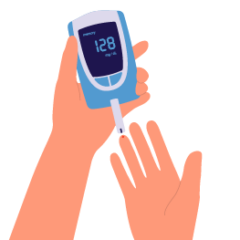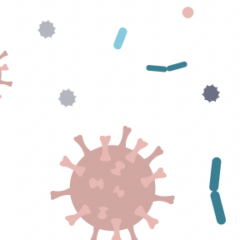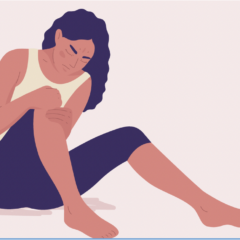Published on
Inflammation and Blood Clots: What You Should Know
You’ve probably heard the word “inflammation,” especially when talking about health. But what does it mean, and what does it have to do with blood clots?
Inflammation occurs when your body tries to heal itself after an injury or when fighting an infection. Your immune system starts this process when it detects something harmful or foreign in your body, like a virus. Blood vessels become more permeable, allowing more immune cells to reach the infected area and help protect it. When immune cells move into the area, you may notice symptoms like swelling, tenderness, and redness around the injury or infection site.
Inflammation can subside within a few hours, depending on the injury or infection your body is fighting. But sometimes, inflammation doesn’t go away, and the cells meant to protect the body end up releasing proteins and hormones that can harm tissues and make the inflammation worse.
Some diseases can cause ongoing—or what we call chronic— inflammation, leading to more damage and other health problems. Common inflammatory diseases include:
- Lupus
- Cancer
- Cystic fibrosis
- Asthma
- Psoriasis
- Multiple Sclerosis
- Diabetes
- Infection (viral or bacterial)
- Inflammatory bowel disease (Crohn’s disease and ulcerative colitis)
How Does Inflammation Cause Blood Clots?
When there’s an inflammatory response in your body, white blood cells called neutrophils release sticky structures called NETs (neutrophil extracellular traps). NETs trap and kill threats to the body, like bacteria and viruses, but also make the inside of blood vessels stickier.
Platelets (small cell fragments in your blood) stick to these NETs and to the walls of blood vessels. When platelets stick together, they can form a clot. The clotting process usually helps stop bleeding but can run amok in the setting of inflammation and block blood flow in the veins. Blood clots in the deep veins are known as deep vein thrombosis (DVT). When these clots travel to the lungs, they are called pulmonary embolism, or PE.
Tips for Reducing Inflammation
There are several things you can do to reduce inflammation and protect yourself from blood clots. Simple changes in your daily routine can make a big impact.
Increase exercise
During exercise, your brain and nervous system release inflammation-fighting hormones. Just 20 minutes of moderate exercise can make a difference.
Decrease stress
Stress can make your immune system too active, increasing inflammation. To lower stress, try meditation, yoga, or deep breathing exercises.
Get enough sleep
Sleep is important for keeping your immune system strong and balanced. Without enough sleep, your body makes more chemicals that cause inflammation. Aim for 7 to 9 hours of sleep each night.
Avoid smoking and excessive alcohol
Smoking puts harmful chemicals into your body that cause inflammation. These chemicals irritate your lungs and other tissues, making your immune system react. The immune system sends cells to attack the toxins from the smoke, thinking they’re a foreign invader.
When you drink alcohol, your liver works to break it down and remove it from your body. This process creates harmful chemicals that can damage liver cells, cause inflammation, and weaken your body’s defenses.
Eat healthy foods
Eating a Mediterranean diet is one of the best ways to lower inflammation. This diet focuses on whole foods like fruits, vegetables, whole grains, nuts, and healthy fats like olive oil. It also includes moderate amounts of fish, poultry, and dairy, while limiting red meat and sweets. If you prefer more flexibility in your diet, you can still choose foods that help reduce inflammation:
- Proteins for the win: Plant-based proteins like beans, lentils, tofu, and quinoa are great for reducing inflammation. If you eat meat, look for grass-fed options. Consider buying in bulk, or from local farmer’s market or co-ops to save on costs. Wild-caught fish is also great. Frozen or canned wild fish offers the same benefits but is easier on the wallet.
- Eat more fiber: Increasing fiber intake can help decrease inflammation. Sources of fiber include whole grains, vegetables, nuts, and beans.
- Eat fruits and vegetables: Berries, cherries, and dark-colored fruits and vegetables are great at lowering inflammation. Aim for at least 5 servings of fruit and vegetables daily.
- Use anti-inflammatory herbs and spices: Spices like paprika, rosemary, ginger, and turmeric can help reduce inflammation. Other good choices include cloves, cinnamon, and sage. Some herbs and spices can interact with blood thinners if used in large quantities. If you’re on a blood thinner, talk to your doctor or pharmacist about using these herbs.
- Choose healthy fats: Avoid trans fats found in baked and fried goods. Limit saturated fats, especially those from animal products. Balance omega-6 and omega-3 fats by eating more fish and leafy greens. Choose monounsaturated fats, like those in olive oil. Try eating dark chocolate: Dark chocolate with at least 70% cocoa can also help lower inflammation.
Understanding how inflammation works and its connection to blood clots is important, especially if you’ve had a clot before. Reducing inflammation can lower your risk of dangerous clots and improve your health. Inflammation is a natural part of your body’s defense system, but it can cause serious health problems when it lasts too long. If you have any questions about inflammation and blood clots, be sure to talk to your healthcare team.
*Originally published in The Beat — October 2024. Read the full newsletter here.
References
Branchford BR, Carpenter SL. The Role of Inflammation in Venous Thromboembolism. Front Pediatr.2018;6:142. doi:10.3389/fped.2018.00142
Eating to reduce inflammation. U.S. Department of Veteran Affairs. https://www.va.gov/WHOLEHEALTH/veteran-handouts/docs/EatReduceInflam__Final508__07-25-2019.pdf. Accessed September 30, 2024.
Elisia, I., Lam, V., Cho, B. et al. The effect of smoking on chronic inflammation, immune function and blood cell composition. Sci Rep. 2020;10(19480). https://doi.org/10.1038/s41598-020-76556-7
Exercise. It does a body good: 20 minutes can act as anti-inflammatory. ScienceDaily. https://www.sciencedaily.com/releases/2017/01/170112115722.htm. Accessed September 30, 2024.
General MS information. National Multiple Sclerosis Society. https://doi.org/10.1016/j.immuni.2021.12.013. Accessed September 30, 2024.
Gillissen A, Paparoupa M. Inflammation and infections in asthma. Clin Respir J. 2015;9(3):257-269. doi:10.1111/crj.12135
Hot to eat a mediterranean diet. U.S. Department of Veteran Affairs. https://www.va.gov/WHOLEHEALTH/veteran-handouts/docs/MedDiet-508Final-9-4-2018.pdf. Accessed September 30, 2024.
Inflammation. National Institute of Environmental Health Sciences. https://www.niehs.nih.gov/health/topics/conditions/inflammation. National Institute of Environmental Health Sciences. Accessed on September 30, 2024.
Inflammatory bowel disease. Centers for Disease Control and Prevention. https://www.cdc.gov/inflammatory-bowel-disease/about/index.html. Accessed on September 30, 2024.
Inflammation. National Institute of Environmental Health Sciences. https://www.niehs.nih.gov/health/topics/conditions/inflammation. National Institute of Environmental Health Sciences. Accessed on September 30, 2024.
Irwin MR. Sleep disruption induces activation of inflammation and heightens risk for infectious disease: Role of impairments in thermoregulation and elevated ambient temperature. Temperature (Austin). 2022;10(2):198-234. doi:10.1080/23328940.2022.2109932
Liu YZ, Wang YX, Jiang CL. Inflammation: The Common Pathway of Stress-Related Diseases. Front Hum Neurosci. 2017;11:316. 2017. doi:10.3389/fnhum.2017.00316
Man AM, Orăsan MS, Hoteiuc OA et al. Inflammation and psoriasis: A comprehensive review. Int J Mol Sci.2023;24(22):16095. 2023. doi:10.3390/ijms242216095
Pahwa R, Goyal A, Jialal I. Chronic inflammation. In:StatPearls. StatPearls Publishing; 2024.
Rohm T, Meier D, Olfefsky M, et al. Inflammation in obesity, diabetes, and related disorders. Immunity. 2022;55:1:31-55. https://doi.org/10.1016/j.immuni.2021.12.013
Sobczak AIS, Stewart AJ. Coagulatory defects in Type-1 and Type-2 diabetes. Int J Mol Sci. 2019;20(24):6345. doi:10.3390/ijms20246345



